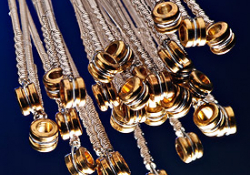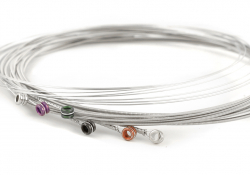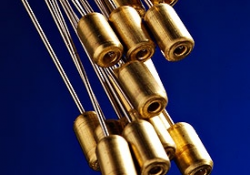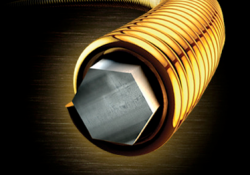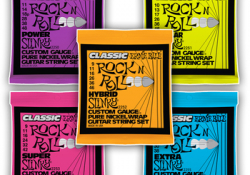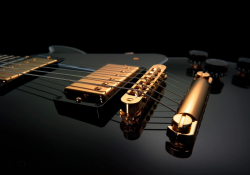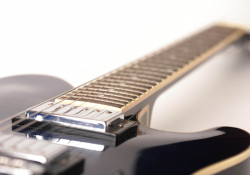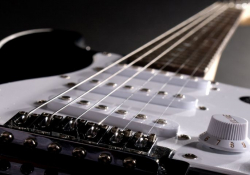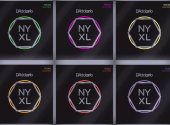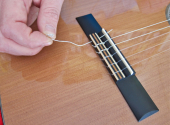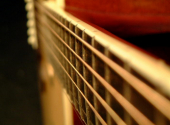
How To Choose Strings for Electric Guitar
The last part of our series on guitar strings is devoted to electric guitar strings. And as in the previous parts, we will start by telling you a little bit about their history and materials for their production, but most importantly about their specific features.
Strings for electric guitar
The history and evolution of electric guitar strings (obviously) dates back to the first electric guitars, that is, roughly to the 1950s. Given the fact that—apart from the wood—one of the basic elements of sound production in electric guitars is the pickup, which creates a magnetic field under the strings, it is self-evident that these strings need to be made of steel. The way the steel string moves (oscillates) when struck with a finger or pick creates a weak electrical voltage, which is induced in a coil inside the pickup and transferred to the guitar amplifier.
The materials and production technology have changed very little over the years and the list of materials remains virtually identical. These are mainly nickel or nickel-plated steel, and occasionally stainless steel. The core of the strings is most often steel (sometimes tin-plated steel) and the main difference is in the material used for the wound strings.
Strings with pure nickel windings (pure nickel) provide a pleasant, warm and round sound, while strings with nickel-plated steel windings (nickel wound) have a bright and clear tone and are among the most popular and most commonly used electric guitar strings. Stainless steel strings (stainless steel) have proven to be particularly durable and long-lasting. The added cobalt or titanium in the steel used in the windings of these strings often contributes to their longer life, making them much stronger.
But over the years, the rise of modern technologies for longer string life has been introduced to electric guitar strings as well. That is why today we can also find strings in this category coated with various nanofibers or polymers that protect the strings from aggressive sweat and dirt.
As with steel acoustic guitar strings, "electric" strings have a round or—by far the most common—a hexagonal core.
As far as windings are concerned, the situation here is also similar to that of acoustic guitar strings: the most common winding is round wound. Less often, we can find ground wound and flat wound, which are in many cases also chrome plated and are particularly popular with jazz players, as they provide a very smooth string surface and a slightly muted sound, typical and sought after for this type of music.
Specifically for electric guitar strings, you will also commonly encounter two types of string endings, either in the shape of a ball (ball end) or a cylinder (bullets). The ending does not have any significant effect on the sound or durability of the strings and it is rather that the cylindrical strings are most often used on guitars fitted with a tremolo, because the cylinder fits a bit better in the tremolo block.
When it comes to choosing string thickness for electric guitar, there's a really big range available. The lightest sets of electric guitar strings are most often .008 gauge, and the thickest can be anywhere around .015 (though you'll rarely see these in practice, as playing on such strings is a bit of a struggle). The most commonly used sets are .009, .010, or .011, or hybrid sets.
The choice of electric guitar strings is therefore very wide, not only in terms of brands and materials, but especially in terms of individual sets. In fact, it is common to find, for example, "nine" sets ending with strings of .040, but also .046. This way, everyone can choose what their fingers can manage and what is enough for them. It takes a bit of skill to perform solos on these "elevens", "twelves"and up. If you like the sound of thicker strings, however, a solution could be to use such a set for lowered tuning. Nowadays, it is common that sets of strings are specifically designed for this.
Verbal labels such as Extra Light, Light, Regular, Medium, etc. for sets are not uniform due to the large number of manufacturers, and, depending on the different string thicknesses of the set, they are often very confusing. But we can at least give an overview of the most common ones:
Extra Light / Extra Super Light – corresponds to sets with a thickness of .008
Super Light / Light / Light Regular – corresponds to sets with a thickness of .009
Regular / Regular Light /Regular Heavy – corresponds to sets with a thickness of .010
Medium – corresponds to sets with a thickness of .011
Heavy – corresponds to sets with a thickness of .012
As already mentioned, each manufacturer uses a slightly different designation, so it is essential to make your choice based on the numbered indication of the individual strings to make sure that the strings will be exactly of the thickness you want. Strings for seven- or eight-string guitars and baritone guitars take up a chapter of their own. More about those some other time.
Was this article helpful to you? Let us know in the comments down below.
If you have found an error or typo in the article, please let us know by e-mail info@insounder.org.

